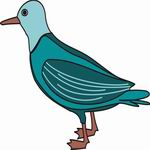- It is found near all oceans and many inland waters.
- Gulls are larger and bulkier than terns, and their tails are squared
rather than forked.
- Their plumage is usually white with gray or black markings on the
back, wings, and head.
- Their long, narrow wings are adapted to soaring and their webbed
feet to swimming.
- They have strong bills, hooked at the end; they eat clams and fish
and sometimes insects, but are most useful as scavengers in harbors
and bays.
- They are often seen hovering over the wakes of ships, seeking refuse,
and frequenting garbage dumps.
- Yellow bill with black ring near the tip.
- Head and underparts white.
- Back light gray.
- Wingtips black with white spots.
- Legs yellow.
- Size: 43-54 cm (17-21 in)
- Wingspan: 105-117 cm (41-46 in)
- Weight: 300-700 g (10.59-24.71 ounces)
- Sexes alike in plumage, male slightly larger than female.
- Young Ring-billed Gulls tested at only two days of age showed a preference
for magnetic bearings that would take them in the appropriate direction
for their fall migration.
- Many, if not most, Ring-billed Gulls return to breed at the colony
where they hatched. Once they have bred, they are likely to return to
the same breeding spot each year, often nesting within a few meters
of the last year's nest site. Many individuals return to the same wintering
sites each winter too.
- Although it is considered a typical large white-headed gull, the
Ring-billed Gull has been known to hybridize only with smaller, black-headed
species, such as Franklin's, Black-headed, and Laughing gulls.
|


